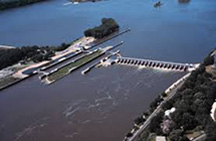Did You Know?
Of the 37 locks and dam sites on the Upper Mississippi and Illinois rivers, only three (locks and dams 27, 26, and 19) have a 1,200 ft. lock chamber. Most of the remainder have 600 ft. lock chambers.
Any flotilla greater than eight barges must be disassembled and moved through a 600 ft. lock chamber in two stages (termed “cuts” by the maritime industry). A standard 15 barge flotilla (five rows; three barges across in width), will approach 1,200 ft. in length. When transiting a 600 ft. lock, the first nine barges will be locked through. The final six barges, along with the tow boat, will then be locked through.
This two-step process of a 15 barge flotilla transiting a single 600 ft. lock will take 1.5 to 2 hours. Because a 15 barge flotilla can transit a 1,200 ft. lock in a single pass with decoupling, it will only take 0.5 to 1 hour to pass through. Therefore, the average time saved to a 15 barge flotilla due to a 1,200 ft. lock is 49 minutes.
|
|

|
Soybean Farmers Explore Potential for Private Investment in Locks and Dams America’s inland waterway system, including the network of locks and dams, has been and continues to be a major contributor to the profitability and competitiveness of the U.S. soybean farmer. For U.S. agriculture, the nation’s navigable waterways are unique not because of their ability to accommodate commercial traffic, but rather due to their close proximity to the most productive farm ground in the world. While other countries have navigable waterways, they are often far removed from those regions most accountable for agricultural production. In the United States, these waterways are very accessible to a high percentage of the nation’s agricultural production, thereby allowing farmers to connect with international customers in a cost effective and reliable manner.
Click here to Read More |
|

|
DOT Report: More than 63,000 bridges need repair; Problem severe in key soybean producing states Recent analysis by the U.S. Department of Transportation reveals the nation has a total of 63,000 bridges that are rated as structurally deficient and in need of repair. Of particular concern to farmers, many of the states with the highest number and/or the highest percentage of structurally deficient bridges are those with sizable soybean production. Click here to Read More |
|

|
Obama administration sends transport bill to U.S. Congress The Obama administration on Tuesday sent a bill to Congress that aims to cover an expected shortage in money to spend on America's bridges, roads and transit systems, but Republican opposition could prevent its passage. Click here to Read More |
|

|
US Navy 'game-changer': converting seawater into fuel Instead of relying on tankers, ships will be able to produce fuel at sea. The US Navy believes it has finally worked out the solution to a problem that has intrigued scientists for decades: how to take seawater and use it as fuel. Click here to Read More |
|
| The Soy Transportation Coalition is comprised of thirteen state soybean boards, the American Soybean Association, and the United Soybean Board.
The National Grain and Feed Association and the National Oilseed Processors Association serve as ex-officio members of the organization. |
|
| Funded by the Soybean Checkoff |






